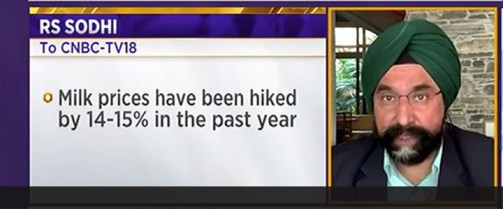On the day Amul hiked milk prices, RS Sodhi, the former managing director of Gujarat Cooperative Milk Marketing Federation (GCMMF) which owns the Amul brand and president of the Indian Dairy Association, told CNBC-TV18 that he believes costs will continue to rise until Diwali this year. He said he expects milk production to start increasing again by winter.
Sodhi said, “All over the world, the dairy prices have stabilised or started going down, but in India, I think till next Diwali situation will be tight as we will not be having any surplus. So, I don’t see prices going down.”
Sodhi also noted that the profitability of the private dairy sector is currently on the decline due to high input costs, which have increased by 20-25 percent for farmers. This has led to a 14-15 percent hike in milk prices over the past year, Sodhi added. Despite this, India still contributes 23 percent to global dairy production.
India’s largest milk producer, Amul, announced a price hike on its pouch milk with immediate effect on Friday. This price hike comes at a time when smaller dairy players have struggled to increase the price of their products. Amul’s price hike may give confidence to them.
“Input costs have increased by over 20-30 percent compared to last year. However, I think the prices will stabilise with good rabi and kharif crops coming in. So, the cost of production may reduce. However, till next Diwali, the situation is tight,” Sodhi added.
To address these challenges, Sodhi believes the country needs a “White Revolution 2.0”. He is encouraged by the Union Budget 2023’s emphasis on cooperatives and the government’s plans to modernise the 63,000 cooperative societies. However, he also notes the need for investment in infrastructure in animal husbandry.
“For animal husbandry, the Budget allocation has been multiplied, and it is now Rs 1,390 crore. Due to the last year’s Lumpy skin disease, I think this is a good Budget allocation. However, we want some Budget allocation for White Revolution 2.0. In the mid-1970s to the mid-1990s, by just Rs 1,000 crore, India became self-reliant and the world’s largest producer of milk. So the same type of one-time investment in infrastructure is needed. We are not asking for any subsidy in dairy, but we want more funds for infrastructure building,” Sodhi said.
Overall, while there are some challenges facing the dairy industry in India, there is also hope for growth and improvement in the future. With a focus on cooperatives and investment in infrastructure, the industry can continue to thrive and contribute to India’s economy.
Source : CNBC TV 18 Feb 3rd 2023 by Manisha Gupta

